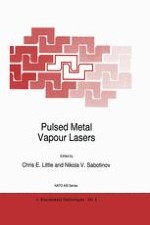1996 | OriginalPaper | Buchkapitel
Impedance Matching and Electric Field Penetration in Metal Vapour Lasers
verfasst von : Pinhas Blau, Ph.D.
Erschienen in: Pulsed Metal Vapour Lasers
Verlag: Springer Netherlands
Enthalten in: Professional Book Archive
Aktivieren Sie unsere intelligente Suche, um passende Fachinhalte oder Patente zu finden.
Wählen Sie Textabschnitte aus um mit Künstlicher Intelligenz passenden Patente zu finden. powered by
Markieren Sie Textabschnitte, um KI-gestützt weitere passende Inhalte zu finden. powered by
In metal vapour lasers (MVL), the lasing atoms are excited by collision with free electrons. The electrons gain their energy from the electric field (EF) within the plasma. High electron energy (in copper vapour laser, about 10 e V) is required in order to create maximal population inversion. This requires strong EF in the plasma (about 100 V/cm for copper vapour laser under normal operation conditions). Ideally the EF should be switched on with as short as possible risetime because gradual rise of the electron energy causes supplement excitation of the lower laser levels. The risetime and strength of the EF depend on the excitation electric pulse, but also on the geometry of the laser tube and on the plasma conductivity. The amplitude and risetime of the electric pulse are limited by the parameters of the excitation circuit, namely, in the conventional circuit, the rating of the thyratron. While working in the maximal thyratron ratings, the value of the capacitor is adjusted in order to deliver the required input energy/power into the laser head. Under these constrain there is poor impedance matching between the circuit and the laser head (this is demonstrated by the amount of reflected power) and apparently the EF in the plasma is not optimal. An optimization of the tube geometry is required in order to enhance the EF. The plasma conductivity, that is determined mainly by the residual electron density, affects the EF and the laser performance dramatically, as will be demonstrated below, but is much more complicated to control.
